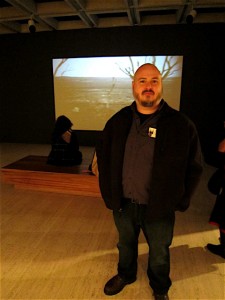On entering the Art Gallery of New South Wales to view the Biennale exhibit I was struck by the sheer haunting beauty of Steadfast, video footage of a lake from Biennale artist Phil Hastings.
Its scope and immensity is like walking into a slow moving Rembrandt.
I connected immediately.
Look Out! there’s a house in the background half flying, half floating, in time and space. How is this possible?
“The work is called Steadfast,” a voice boomed behind me. It was Phil Hastings, just the man I needed to talk to.
“Some people think it looks like a Turner,” he said.
I asked him what inspired the work.
“I was looking out the window to see what the weather was like and I knew there was something special about what was happening outside,” he said.
“I ran out to capture it, not knowing what I’d do with it but I was really interested and inspired by being close to the lake. It’s the first time that I’ve moved close to a large body of water, and I had two young boys with me who were experiencing it for the first time as well.”
In 2009 a flood that hit the town where Hastings lived devastated a lot of houses.
“I had shot the video earlier in the year but when I came back to it after the flood, it really came together,” he said.
Given that this is a very ‘painterly’ work, I asked whether it was most influenced by an interest in the visual arts, or video and film.
“Well, I’m certainly influenced by sculpture; that was my original background, so when I look at starting a project it’s almost always about constructing,” Hastings said.
“I use whatever I shoot as the raw stock and push it around as much as I can on the computer or in front of the lens, but it’s always about constructing.”
That craftsmanship is evident in Steadfast where the footage is dramatically slowed down so that it’s almost like seeing the sculpture and structure of the water, the ‘solidness’ of it.
“Yeah, the idea of slowing it down was really inspired by this idea of wanting to hone in on what is actually happening, to really explore that single moment in time and stretch it out as long as possible,” he explained.
“Kind of embrace the craziness but at the same time find peace and calm.”
This video is part of a series about the lake and his relationship to it, Hastings reveals.
“I broke it down into the idea of the elements, so earth-wind-fire-water, just as a way of defying the limitations,” he said.
“But slowing it down was really important to me, so all the pieces are slowed down. My other work deals with some other kind of investigation, so a lot of close up imagery, almost microscopic.”
The interest in science is no surprise given that his father was a science teacher. His own studies focused on art and sculpture.
“I love building and filming stuff and interacting with it. Then I start to feel there’s more that could be done with it, so I start building things to shoot, building sets and props and then it’s one step to something else, more narrative-like, so I build the sets, I build the props, I do the costumes, I do the lighting,” he said.
“The narrative work is much slower. But what I like on the experimental side is that the narrative is constructed by the audience who can project onto it also, to bring their own history and experiences to it. The more traditional narrative form is a much more labour intensive process.”
Intrigued, I ask whether the lake has flooded again.
“The flood that I experienced wasn’t because of the lake, but the lake every winter gets really stormy like that, except for last winter, it didn’t freeze, which is the first time ever, so it’s a climate change thing.
“You guys here in Sydney are experiencing it, all this water, so I’m right there with you on that. Then we had this really dry winter that was strange and messed up all our crops up state.”
So what’s in the pipeline?
“I’m finishing the last two in this series, re-shooting some and trying to secure facilities for where I will be burning something on the lake, hopefully a ship. We’ll see,” he said.
Wow, a Viking funeral…
“Yeah, or at least recording someone else doing it. I’ve got a whole other series I’m calling the Morphology series which is taking raw material and creating microscopic organisms out of it and using that as a projected installation.”
STEADFAST can be seen at the AGNSW until September 16, 2012 as part of the 18th Biennale of Sydney.
Phil Hastings is a filmmaker and 2012 NYFA Film/Video Fellow. His films include animation, experimental and narrative modes of working. He currently teaches experimental video in the Department of Visual Arts and New Media at SUNY Fredonia. He has also taught at Kenyon College and University of Virginia.





